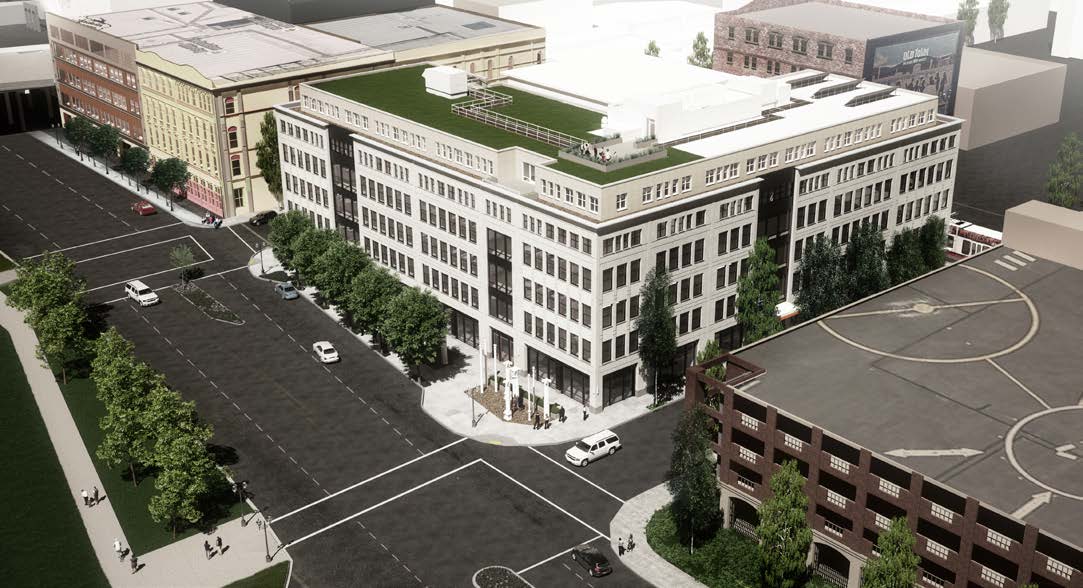
The Block 8L building in Skidmore Old Town, which is now under construction. The design was cited as an example of the positive contribution made by the Historic Resource Review process.
The Historic Landmarks Commission has presented its 2015 State of City Preservation Report to the Portland City Council. The report gave an update to the Council on the work of the Commission, made suggestions for priorities to be addressed in the coming year and identified potential threats to historic resources in the city. Presenting the report was outgoing Chair Brian Emerick, joined by Commission member Kirk Ranzetta. A similar report was delivered earlier in the year by the Design Commission.
The full presentation is available to view below, however due to a technical error audio is missing until public testimony begins. Subtitles are available.
While most major Designs Reviews in Porltand are performed by the Design Commission, the Historic Landmarks Commission reviews projects located in designated Historic Districts, or projects that alter buildings listed on the National Register of Historic Places. Projects approved by the Landmarks Commission in the past year include Block 8L, the NW 21st and Irving Apartments, the Northwest Portland Youth Hostel, the Cornelius Woodlark Renovation, the Grove Hotel, the Marcus Apartments and the Mason Erhman annex renovation. The Commission has also offered Design Advice for Restoration Hardware, Grand Belmont and 2161 SW Yamhill.
Beyond performing Design Review, a broader task given to the Landmarks Commission is to provide advice on historic preservation matters, which formed the bulk of the State of City Report. The HLC identified 5 priorities for 2016:
- BPS Planning Position: The Historic Landmarks Commission is staffed by planners at the Bureau of Development Services who assist with design reviews, but there is no dedicated planner at the Bureau of Planning & Sustainability to help with tasks such as code writing. BPS is currently planning on filling this position by the end of the year.
- Design Guidelines: Design Review cases in Portland are reviewed against a set of guidelines, yet most designated Historic Districts in the city lack specific guidelines and therefore default to more general approval criteria including the River District Design Guidelines or the Community Design Guidelines. The Skidmore Old Town Historic District does have a specific set of guidelines, however they are generally seen as being very outdated. A project to update them has been underway for years, but has repeatedly stalled. The Landmarks Commission stressed the need to finally adopt the new guidelines for Skidmore Old Town, and work on development guidelines for districts that lack them, such as New Chinatown / Japantown.
- Historic Resource Inventory: Portland’s last citywide inventory of historic buildings was completed in 1984. As such it lacks any information on areas subsequently annexed to the city, including almost all of East Portland. Mid-century buildings, then too recent to be considered historic, are also lacking from the inventory. Developing the scope of a new HRI would be one of the tasks given to the person who fills the BPS planning position.
- Unreinforced Masonry Structures: Many of Portland’s historic buildings are built of unreinforced stone or brick, which makes the buildings very vulnerable in an earthquake. The HLC is supportive city efforts to encourage seismic retrofits, but is concerned that a mandatory retrofit policy (if adopted) will have the unintended consequence of encouraging the demolition of older buildings. The report notes that upgrades “are already expensive when triggered as part of a larger redevelopment project, ranging from $25/sf to $100+/sf depending on the building and its use. However, there is a further premium to do seismic upgrades outside of a shell rehabilitation project. When a building is already occupied and finished, the work is typically more expensive, but rarely is there a direct financial upside that comes with this investment.”
- Balancing Preservation and Density: The strong real estate market has created what some call a “demolition epidemic” that threatens historic buildings and districts. Recognizing the need for growth in the city, the HLC’s preferred approach is to “see density focused on urban corridors and intact vintage neighborhoods preserved wherever possible”. An example given of a building that could threaten a Historic District was the “humongous” Grand Belmont, which the Commission pointed out would be located in a district primarily composed of two or three story buildings.
Potentially threatened buildings mentioned in the report include Veteran’s Memorial Coliseum, the Multnomah County Courthouse, Centennial Mills and the USPS Processing and Distribution Center. The development at SW 3rd & Taylor, which would see the demolition of the Hotel Albion and the Ancient Order of United Workmen Temple, was specifically brought to the City Council’s attention. While early plans showed the retention of the Temple building, drawings being presented to the Design Commission today show both being replaced with new buildings. (Next Portland will publish a post about 3rd & Taylor next week.)
The full report is available here [PDF].